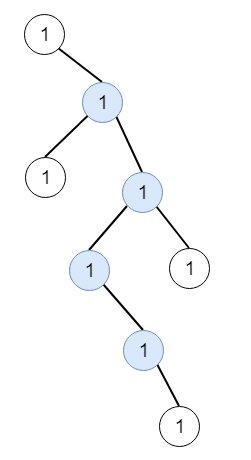
 Data Structure
Data Structure Networking
Networking RDBMS
RDBMS Operating System
Operating System Java
Java MS Excel
MS Excel iOS
iOS HTML
HTML CSS
CSS Android
Android Python
Python C Programming
C Programming C++
C++ C#
C# MongoDB
MongoDB MySQL
MySQL Javascript
Javascript PHP
PHP
- Selected Reading
- UPSC IAS Exams Notes
- Developer's Best Practices
- Questions and Answers
- Effective Resume Writing
- HR Interview Questions
- Computer Glossary
- Who is Who
Longest ZigZag Path in a Binary Tree in C++
Suppose we have a binary tree root, a ZigZag path for a binary tree is defined as follow −
Choose any node in the binary tree and a direction (either right or left).
If the current direction is right then moving towards the right child of the current node otherwise move towards the left child.
Then change the direction from right to left or vice versa.
Repeat the second and third steps until we can't move in the tree.
Here the Zigzag length is defined as the number of nodes visited - 1. (A single node has a length of 0). We have to find the longest ZigZag path contained in that tree. So for example, if the tree is like −

The output will be 3, as (Right, Left, Right)
To solve this, we will follow these steps −
Define a method called dfs(), this will take root and leftB
if root is null, then return -1
if root is only one node in the tree, then return 0
leftV := dfs(left of root, true) and rightV := dfs(right of root, false)
ret := max of ret and (1 + max of leftV and rightV)
if leftB is not 0, then return 1 + rightV, otherwise return 1 + leftV
From the main method, set ret := 0
call dfs(root, true) and call dfs(root, false)
return ret
Example (C++)
Let us see the following implementation to get a better understanding −
#include <bits/stdc++.h>
using namespace std;
class TreeNode{
public:
int val;
TreeNode *left, *right;
TreeNode(int data){
val = data;
left = right = NULL;
}
};
void insert(TreeNode **root, int val){
queue<TreeNode*> q;
q.push(*root);
while(q.size()){
TreeNode *temp = q.front();
q.pop();
if(!temp->left){
if(val != NULL)
temp->left = new TreeNode(val);
else
temp->left = new TreeNode(0);
return;
} else {
q.push(temp->left);
}
if(!temp->right){
if(val != NULL)
temp->right = new TreeNode(val);
else
temp->right = new TreeNode(0);
return;
}else{
q.push(temp->right);
}
}
}
TreeNode *make_tree(vector<int> v){
TreeNode *root = new TreeNode(v[0]);
for(int i = 1; i<v.size(); i++){
insert(&root, v[i]);
}
return root;
}
class Solution {
public:
int ret;
int dfs(TreeNode* root, bool leftB){
if(!root) return -1;
if(!root->left && !root->right) return 0;
int leftV = dfs(root->left, true);
int rightV = dfs(root->right, false);
ret = max(ret, 1 + max(leftV, rightV));
if(leftB) return 1 + rightV;
return 1 + leftV;
}
int longestZigZag(TreeNode* root) {
ret = 0;
dfs(root, true);
dfs(root, false);
return ret;
}
};
main(){
vector<int> v = {1,NULL,1,1,1,NULL,NULL,1,1,NULL,1,NULL,NULL,NULL,1,NULL,1};
TreeNode *root = make_tree(v);
Solution ob;
cout << (ob.longestZigZag(root));
}
Input
[1,null,1,1,1,null,null,1,1,null,1,null,null,null,1,null,1]
Output
3

